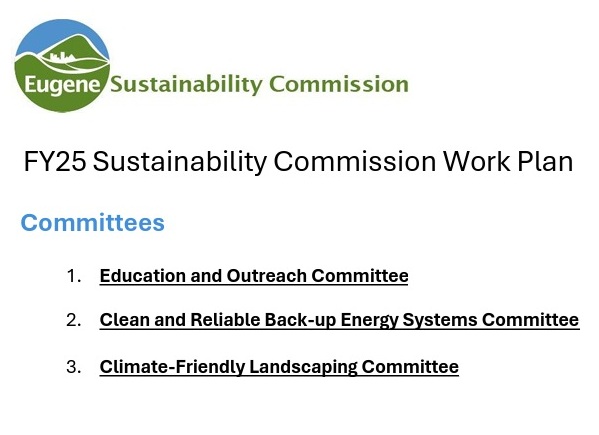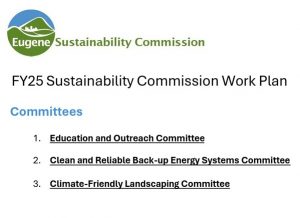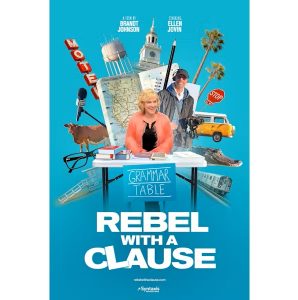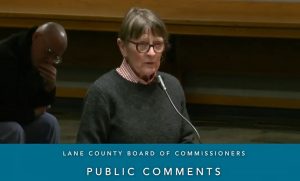Councilors ask city to help develop local carbon offsets
9 min read
Presenter: The Sustainability Commission and staff are asked to keep payments for carbon offsets within the local economy. With the City Council Nov. 19, Danielle Klinkebiel:
Danielle Klinkebiel: My name is Danielle Klinkebiel. I am a climate policy analyst for the city, and part of my duties include being the staff liaison for the Sustainability Commission. With me today is Alexi Miller, the vice chair of the Sustainability Commission.
[00:00:25] Presenter: An assistant director at the Oregon Department of Energy, City Councilor Alan Zelenka:
[00:00:32] Councilor Alan Zelenka: I know that the Sustainability Commission has addressed this before, but we buy offsets to fulfill our commitment to the climate recovery ordinance, and we’ve been trying to get as local as possible. I’m wondering if that’s something we could add to the work plan in terms of looking at more local offsets than what we’ve seen in the past.
[00:00:56] Danielle Klinkebiel: Thank you, Councilor Zelenka, that’s a great question.
[00:00:59] Staff continue to purchase carbon offsets to achieve our net zero goal through the climate recovery ordinance. And several years ago, the Commission did stand up a committee to list out their priorities for how we make those decisions around which offsets to purchase.
[00:01:15] Currently staff do try as best as possible to balance prioritizing as local as offsets as possible, while also within the budget that we have to purchase those carbon offsets.
[00:01:27] And so as staff, I’m not totally certain what role the Commission would have beyond, you know, the values and goals that they’ve already listed out in their committee work a few years ago.
[00:01:40] Councilor Alan Zelenka: I applaud the efforts you’ve done so far, but what’s missing from that is a plan to develop local offsets that we can use. And we don’t have any.
[00:01:49] There’s lots of things that are occurring that could be actually turned into projects that we could end up purchasing—local economic development projects for businesses that switch their fleets over to EVs, or do other kinds of things that lower their fossil fuel use and emissions.
[00:02:05] So developing a plan to develop local offset projects is really what’s needed in the next step. So I was hoping that the Sustainability Commission could do that.
[00:02:16] The next thing coming down the pike for buildings—especially in the commercial sector—is the building performance standards that the legislature passed in 2023, and that early-adopter incentives are in place for people to make their existing buildings, getting them up to average energy use.
[00:02:33] So that would be a good thing as an economic development tool, to be able to have our local businesses take advantage of those incentives while they last, because they’re not unlimited. So that’s going to come out very soon.
[00:02:45] And then finally, on the triple bottom line, hopefully you’re all aware of the massive amount of history we’ve had with triple bottom line and that’s part of the TBL tool that was developed and all the history that we’ve had in trying to apply that to the work that we do.
[00:03:02] It’s kind of gone a little bit out of vogue, but hopefully we can bring that back as an important part of our decision-making tool: What are the impacts on the triple bottom line?
[00:03:12] Presenter: Councilor Mike Clark.
[00:03:13] Councilor Mike Clark: I just want to second Councilor Zelenka’s suggestion (strong suggestion, motion, whatever it ends up being) there, that as someone who’s been really unhappy at us purchasing carbon offsets out of market for the history of that program, I view that as us just taking local taxpayer money and sending it out of the market so we can feel good.
[00:03:40] And we should be developing and should have a program to develop local offset opportunities so that that money stays within our community. The days of us sending money out of the community so we can feel good need to be over.
[00:03:57] Danielle Klinkebiel: Apologies, I just want to interject. I think there are local conversations happening with staff and our partners about developing local offset projects. I think so far there hasn’t been a specific project that has emerged from those conversations. These are expensive things to stand up, but there are local conversations happening about how to explore those opportunities.
[00:04:19] Councilor Mike Clark: It’s good that the conversations are happening. The days of us sending money out of the market so we feel good, though, really need to be over. In my opinion. So I hope that develops very quickly by the time we hit a new budget season.
[00:04:33] Lastly, I’ve been asked a number of times by constituents, and I don’t have an answer for this, maybe you can with the work that you’re doing. The third leg of the triple bottom line analysis is essentially the cost efficiency of an action and/or the cost of an action. I wonder if we have such an analysis on our climate work in total as a community.
[00:04:57] Do we have any kind of information that says: ‘All of the money that the city has spent in the last X number of years has alleviated X number of tons of carbon entering the atmosphere, but here’s cost overall for doing so.’ Do we have an analysis of that nature?
[00:05:17] Danielle Klinkebiel: Thanks for that question. That’s a hard question for me to answer because I think a lot of the money that has been spent to advance our climate goals is also in service to other initiatives that the city is moving forward.
[00:05:29] Our climate work is very interwoven across the whole city with our housing work, with our infrastructure projects, with our long-range planning efforts. And so it’s challenging to tease that dollar amount out.
[00:05:44] How much would it cost reach our climate goals? Is there a dollar amount for that? And again, I think that’s a challenging question to answer because as we meet those climate goals, it’s very interwoven with a lot of the other work that’s happening across the city.
[00:05:57] Councilor Mike Clark: Isn’t that the nature of the triple bottom line tool itself, understanding the cost efficiency and effectiveness of any particular action?
[00:06:07] Danielle Klinkebiel: The triple bottom line is an attempt to understand the impact of projects and policies as they are developed. So, across three different categories: there’s (1) what are going to be the social impacts, (2) what are going to be the environmental impacts, and (3) what are going to be the economic impacts of any type of decision or policy once it gets implemented.
[00:06:27] And the goal of the tool is to really be aware of possible unintended impacts as you’re making those policy decisions. So—
[00:06:36] Councilor Mike Clark: We don’t have metrics essentially on costing for the effort itself overall. Would you say that’s accurate?
[00:06:45] Danielle Klinkebiel: My understanding of the TBL tool is it’s not really meant to budget out and cost out. The purpose of it is really to understand the various impacts that this policy could have. So, yes, cost to do that is one of those, but I can’t give you a number right now about the exact cost it’s going to take to implement or achieve our climate goals.
[00:07:06] Councilor Mike Clark: Okay. Thank you.
[00:07:08] Presenter: Vice Chair of the Sustainability Commission Alexi Miller:
[00:07:12] Alexi Miller: Just really briefly, if I may. One thing I’ll note, Danielle said at the beginning, we’re 67% implemented on CAP (Climate Action Plan) 2.0. That includes strategies or action steps that have completed as well as those that have been started and are in progress.
[00:07:28] And so, while they may have a cost, in some cases, you pay up front and you get the benefits for years to come. And so the answer might be a little bit nuanced in terms of ‘How much have we spent and how many tons have we avoided emissions from our CAP 2.0 strategies?’ because some of them are in progress.
[00:07:51] Or like a bikeway. Say that you build the bikeway and the presumably-reduced car trips sort of accrue over time. So these things can be estimated, but it’s a little hard to say, ‘Here’s where we’re exactly at right now.’
[00:08:06] Presenter: Councilor Mike Clark:
[00:08:08] Councilor Mike Clark: Sure. And I appreciate the difficulty, certainly. But I hope you understand there’s a lot of constituents of mine who asked the question in a difficult budget time when we had shortages and we have to contemplate increases.
[00:08:22] These particular expenditures need to have, in my opinion, better metrics around them so that we can explain to the general public and to our constituents why we’re spending that money.
[00:08:33] And so I’m just trying to find a better way to explain that with metrics that make sense with folks based on the kind of questions I’m getting. So it’s just information that I’m looking, can we do that, please? But I understand. Thank you very much.
[00:08:50] Presenter: Councilor Alan Zelenka:
[00:08:52] Councilor Alan Zelenka: I wanted to correct two misconceptions that have been put out there. One is that offsets are not feel-good projects. In order for us to buy one, they must meet the ‘but-for’ test, meaning that they actually reduce greenhouse gas emissions and ‘but for’ our purchase, they would not have happened. So we’re enabling those to occur.
So they’re not feel-good projects, they’re actual reductions and energy efficiency. The analogy would be when EWEB pays you to do weatherization in your house, they’re paying you to do that action so that you use less energy so they don’t have to buy it. That’s an offset. It’s just in a different format.
[00:09:36] The other one is that if you look at the enormous body of work that has been done over the years on climate action plans, most of the actions that get proposed and a lot of the actions in our CAP 2.0 actually reduce cost and end up creating a net benefit as opposed to a net cost, both to user and society.
[00:10:03] So, of course, you have to do the homework to be able to understand that. But most of the actions you can take are on the far left side of the MAC (marginal abatement cost) curve are going to create net benefits, not have net costs. And that’s been studied over and over again. So it’s not true that climate change actions are costly, they’re actually net benefits.
[00:10:25] Finally, one of the things that I was thinking about on local offsets is that what we really need to do is put out an RFP and design something that actually solicits local businesses and local nonprofits to take action.
[00:10:43] We don’t need to pay for the entire project. We just need to create the tipping point for them to go from no to yes, because we give them the incentive.
[00:10:50] You could do it by providing a dollar per metric ton kind of limit or offer, and then people can choose to do that. Local nonprofits or businesses can choose take actions that they wouldn’t otherwise take that would lower greenhouse gas emissions.
[00:11:06] And then finally on the the reason TBL is important is because decisions are not and should not be made solely on economic criteria. So they need, and we often do in your everyday decisions that you make in your household, and at the city level that we make, they take into the impacts on society and equity and also onto the environment. Those things are often left out.
[00:11:33] So they’re just creating a level playing field with all the decision-making factors that should be taken into consideration on deciding something.
[00:11:41] Presenter: The city is asked to help keep carbon offset payments within the local economy, as questions are raised about the sustainability program’s costs and benefits.





